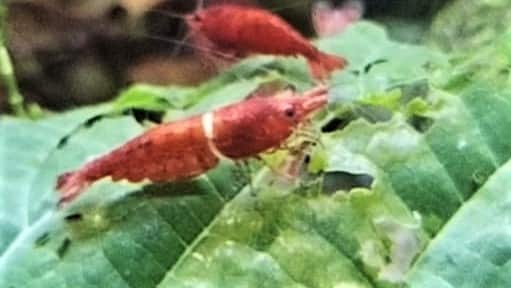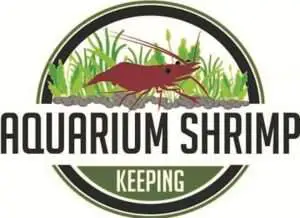Picture this: You’re gazing into your shrimp tank, mesmerized by the delicate dance of your cherry shrimp. Suddenly, you notice something peculiar—a shell, but no shrimp inside. A molt! You realize that this natural process is a mystery to you. How often do cherry shrimp molt? Why does it happen? And what does it mean for your shrimp’s well-being?
Cherry shrimp molt at different stages of their lives, with adults molting once a month and newborns molting every day or two. The molting schedule is closely tied to egg gestation and can be influenced by factors such as temperature. Understanding and supporting this process is essential for a healthy shrimp tank.
Over the years, I’ve faced these questions and more. From the joy of witnessing a newborn shrimp molt every day to the concern of an adult shrimp holding onto eggs for too long, the molting process has been a fascinating and sometimes nerve-wracking journey. I’ve seen how temperature can affect the gestation period, and I’ve even lost a shrimp to the stress of delayed molting.
In this post, we’ll explore the world of cherry shrimp molting, unraveling the complexities and shedding light on how to support your shrimp through this natural process. So grab your net and your water testing kit, and let’s dive into the deep end of shrimp molting. Your shrimp will thank you, and who knows, you might even catch a molt in action!
What Triggers Molting in Cherry Shrimp?

Molting in cherry shrimp is a fascinating and complex process that’s triggered by a combination of factors. At the heart of it, molting is a natural growth mechanism. As shrimp grow, their hard exoskeleton doesn’t expand with them. So, they must shed or “molt” this rigid shell to allow for further growth.
The frequency of molting is influenced by the shrimp’s age, with newborns molting as often as every day or two, while adults typically molt once a month. This adult molting schedule often coincides with the egg gestation time, which ranges from 21 to 28 days, depending on the temperature.
Speaking of temperature, it plays a vital role in the molting process. A lower temperature can prolong the gestation period, causing the female shrimp to hold onto the eggs longer before molting. This delay can sometimes lead to stress in the shrimp, even to the point where they might die.
Diet and water quality are other significant factors. A well-balanced diet rich in essential minerals like calcium helps in forming a healthy new shell. Water parameters such as pH, hardness, and salinity need to be in the optimal range to support molting. Any sudden changes in these parameters can disrupt the molting process, leading to potential health issues.
In essence, molting in cherry shrimp is a delicate dance influenced by age, temperature, diet, and water quality. Understanding these triggers and maintaining a stable environment is key to ensuring a successful molt, allowing your shrimp to grow and thrive in their aquatic home.

How Can Shrimp Keepers Support the Molting Process?
Supporting the molting process in cherry shrimp is akin to being a backstage crew for a theatrical performance. It’s all about setting the stage and ensuring everything runs smoothly. As shrimp keepers, we must recognize that molting is a natural and essential process for shrimp growth, and our role is to facilitate it.
First and foremost, maintaining stable water parameters is crucial. Sudden pH, hardness, or salinity changes can disrupt the molting process. When necessary, regular monitoring and gentle adjustments create an environment where shrimp can molt without stress.
Temperature plays a vital role as well. Keeping the water temperature within the optimal range for cherry shrimp (around 22-24°C or 72-75°F) ensures that the molting and egg gestation schedules align properly. A stable temperature helps prevent undue stress that can lead to complications during molting.
Diet is another area where shrimp keepers can lend a helping hand.Providing a balanced diet that includes essential minerals like calcium supports the formation of a healthy new shell. Foods specifically designed for shrimp often contain these necessary nutrients. Occasional supplementation with mineral-rich foods like spinach can also be beneficial.
Lastly, providing hiding spots and a calm environment is essential, especially during molting. Shrimp are vulnerable during this time, and having places to hide can make them feel secure. Plants, rocks, or specially designed shrimp hides can serve this purpose.
In a nutshell, supporting the molting process in cherry shrimp is about understanding their needs and creating a stable, nurturing environment. It’s about being attentive without being intrusive, allowing nature to take its course while providing the right conditions for success. It’s a rewarding endeavor that deepens our connection with these fascinating creatures and allows us to witness one of nature’s remarkable transformations.
What Are the Signs of a Healthy Molt in Cherry Shrimp?
Ah, the molt! It’s a sign of growth and a healthy life in the world of cherry shrimp. But how do we, the proud shrimp keepers, recognize a healthy molt? Let’s dive into the subtle art of molt-spotting.
A healthy molt begins with the shrimp’s behavior. You might notice your shrimp becoming more reclusive or hiding more often. This is a natural response as they prepare for the vulnerable process of shedding their old shell. Don’t be alarmed if they seem a bit shy; they’re just getting ready for the big event.
Next, you might observe the old shell itself, often intact and empty, lying on the tank’s bottom. It’s a fascinating sight and a clear indication of a successful molt. The old shell might look like a ghostly replica of your shrimp, but fear not, it’s just nature’s way of saying, “Job well done!”
The shrimp’s appearance post-molt is another sign of a healthy process. They should look vibrant, with a shiny and smooth new shell. You might even notice a slight increase in size, a testament to their growth.
It’s also common for female shrimp to molt shortly before or after releasing their eggs. This synchronization with the reproductive cycle is a natural and positive sign of a healthy molt.
Remember that a healthy molt doesn’t necessarily mean immediate feasting on the old shell. While some shrimp might devour the old shell to reclaim the minerals, others might ignore it entirely. Both behaviors are normal.
In the grand scheme of shrimp keeping, recognizing a healthy molt is about observing and understanding these signs. It’s about appreciating the natural rhythms of your shrimp’s life and celebrating these milestones. A healthy molt is a joyous occasion, a little shrimp party in your tank, and you’re invited to witness the magic unfold. So grab your favorite magnifying glass and enjoy the show!
What Common Problems Occur During Molting, and How Can They Be Addressed?

While a natural and essential process, molting in cherry shrimp isn’t always smooth sailing. Sometimes, the seas get a bit choppy, and problems arise. But fear not, fellow shrimp keeper! Understanding these common problems and how to address them can turn potential disasters into ripples in the water.
One common issue is a failed molt, where the shrimp is unable to shed its old shell fully. This can lead to a condition known as “white ring of death,” where a white band forms near the shrimp’s head, trapping it in the old shell. This often indicates a lack of essential minerals in the diet or water. Addressing this requires ensuring a balanced diet rich in minerals like calcium and maintaining optimal water hardness.
Another problem might be the sudden death of a shrimp after molting. This can be shocking and disheartening, especially when everything seems fine. Often, this is related to stress caused by sudden changes in water parameters or poor water quality. Regular monitoring and gentle adjustments to stabilize the water parameters can prevent this tragic turn of events.
Sometimes, shrimp may become more susceptible to predators or aggressive tank mates right after molting. Their new shell takes time to harden, leaving them vulnerable. Providing plenty of hiding spots and ensuring a peaceful tank community can mitigate this risk.
Lastly, a prolonged or delayed molting process might indicate underlying issues such as low temperature or stress. Keeping the temperature within the optimal range and providing a calm environment can support a timely molt.
In the world of shrimp keeping, problems during molting are like plot twists in a gripping novel. They add complexity and challenge, but with understanding and care, they can be overcome.
It’s about being a vigilant and empathetic keeper, ready to step in when needed and trusting in these remarkable creatures’ natural resilience. After all, every molt is a new beginning, a fresh start, and a chance to grow. And isn’t that what life is all about, even in a shrimp tank?
Conclusion: Understanding and Supporting Cherry Shrimp Molting
In summary, the world of cherry shrimp molting is a delicate dance filled with growth, transformation, and occasional challenges. From recognizing the triggers of molting to spotting signs of a healthy molt and addressing common problems, we’ve explored the intricate details of this fascinating process.
By maintaining a stable environment, providing a balanced diet, and being attentive to our shrimp’s needs, we can support them through each molt, ensuring a thriving and vibrant shrimp tank.
On a final note, if you find yourself in uncharted waters or need any help navigating the molting process, please don’t hesitate to reach out. Check out Aquarium Shrimp Keeping on Facebook if you can’t reach me here. Happy Shrimp Molting, and may your tank be filled with joyous little shell-shedding celebrations!
FAQ: Understanding Cherry Shrimp Molting
Q. How do you know if cherry shrimp is molting?
A. You can recognize that a cherry shrimp is molting by observing specific behaviors and signs. The shrimp may become more reclusive or hide more often as it prepares to shed its old shell. After the molt, you might find the old shell, often intact and empty, lying at the bottom of the tank. The shrimp’s appearance post-molt should be vibrant, with a shiny and smooth new shell.
Q. Why is my cherry shrimp failing molting?
A. Failed molting in cherry shrimp can be due to various factors, such as a lack of essential minerals in the diet or water, sudden changes in water parameters, or poor water quality. Ensuring a balanced diet rich in minerals like calcium and maintaining stable water conditions can help prevent failed molts.
Q. Is it good that my shrimp are molting?
A. Yes, molting is a natural and essential process for shrimp growth. It allows the shrimp to shed its rigid old shell and grow a new one, accommodating its growing body. A successful molt is a sign of a healthy shrimp and a well-maintained environment.
Q. Do shrimp molt when stressed?
A. Stress itself does not typically trigger molting in shrimp. However, stress can lead to problems during the molting process, such as delayed or failed molts. Factors like sudden changes in water parameters or poor water quality can cause stress and disrupt the molting process.
Q. How fast do shrimp molt?
A. The frequency of molting depends on the shrimp’s age and other factors. Newborn cherry shrimp can molt every day or two, while adults typically molt once a month. The molting process itself takes a few hours, during which the shrimp sheds its old shell and hardens the new one.
Q. How do you promote molting in shrimp?
A. Promoting healthy molting in shrimp involves maintaining stable water parameters, providing a balanced diet rich in essential minerals, and keeping the water temperature within the optimal range. Regular monitoring and gentle adjustments to water conditions, along with a well-balanced diet, create an environment where shrimp can molt successfully.
These FAQs provide a comprehensive overview of cherry shrimp molting, addressing common questions and concerns. Understanding these aspects helps shrimp keepers support their shrimp through this fascinating and essential process. Happy Shrimp Keeping!
